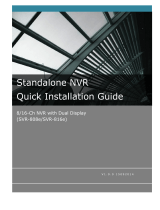
iiD-Link DNR-326 User Manual
Table of Contents
Manual Overview .......................................................................i
Manual Revisions ........................................................................... i
Trademarks ...................................................................................... i
Package Contents ......................................................................1
Features ............................................................................................ 4
Hardware Overview ..................................................................... 7
Front View ................................................................................ 7
Rear Panel (Connections) ...................................................8
Installation ..................................................................................9
Install the Hard Drives ................................................................. 9
Getting Started ............................................................................12
D-Link NVR Search Utility ........................................................13
Web UI Login ................................................................................15
Auto Search Camera ..................................................................16
Web UI ............................................................................................18
Setup ...............................................................................................19
Conguring the NVR .......................................................... 19
Network Setup ..................................................................... 20
Camera Search .....................................................................21
Camera Setup ....................................................................... 22
Audio and Video .................................................................. 23
2nd Stream Settings ..........................................................24
Live and Playback Setup ..................................................25
Recording Schedule ........................................................... 26
Auto Backup .........................................................................29
Event Setup ........................................................................... 30
E-mail Setup..........................................................................31
Time and Date ...................................................................... 32
Maintenance ................................................................................33
User Management ..............................................................33
System ....................................................................................35
Firmware Upgrade ..............................................................36
RAID .........................................................................................37
Dynamic DNS .......................................................................39
Status ..............................................................................................40
Camera Status ......................................................................40
System Info ...........................................................................41
Logs .........................................................................................42
NVR Log ..................................................................................43
Support ..........................................................................................44
Live Video ......................................................................................45
LiveView Setting .........................................................................48
Multiple View ...............................................................................51
Playback .........................................................................................52
Record and Playback Settings ........................................55
Search the Recorded Video For Playback ................... 56
Smart Search from the Recorded Video .....................58
Recorded Video Enhancement ......................................60
Save Video .............................................................................61
Save Image ............................................................................62
Table of Contents




















